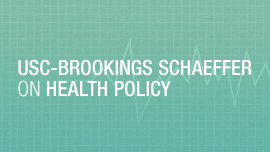This analysis is part of the USC-Brookings Schaeffer Initiative for Health Policy, which is a partnership between the Center for Health Policy at Brookings and the University of Southern California Schaeffer Center for Health Policy & Economics. The Initiative aims to inform the national health care debate with rigorous, evidence-based analysis leading to practical recommendations using the collaborative strengths of USC and Brookings.
This article originally appeared in Health Affairs on September 14, 2017.
Network adequacy was one of the many critical issues that the Trump administration confronted when it took over responsibility for administering the Affordable Care Act (ACA). In an effort to provide greater consumer value, insurers in the ACA’s reformed Marketplace have shifted to much narrower provider networks than had existed previously. Many analysts view this as a potentially positive development, but others are concerned that patients will receive inadequate care, especially those individuals with higher-cost conditions. Regulators face the tough task of protecting patients without squelching market innovations that can control costs.
Faced with these issues, the Trump administration punted. On April 13, 2017, its first health care regulation, the Market Stabilization Final Rule, “proposed to rely on State reviews for network adequacy…in States with the authority that is at least equal to the [ACA’s] reasonable access standard.” In practical terms, this shift to state oversight represents a significant departure from the Obama era. Under the Obama administration, the Centers for Medicare and Medicaid Services (CMS) reviewed all qualified health plans (QHPs) in the ACA market in states that did not operate their own exchanges. Through this review process, CMS ensured that all QHPs on the federally facilitated exchanges met basic quantitative standards designed to ensure network adequacy (see Exhibit 1).
Exhibit 1: CMS Quantitative Network Adequacy Standards
 Source: Center for Consumer Information and Insurance Oversight. 2017 letter to issuers in the federally facilitated Marketplaces. Washington (DC): Centers for Medicare and Medicaid Services; 2016 Feb.
Source: Center for Consumer Information and Insurance Oversight. 2017 letter to issuers in the federally facilitated Marketplaces. Washington (DC): Centers for Medicare and Medicaid Services; 2016 Feb.
With this final rule, the Trump administration eliminated this federal review process, ceding network adequacy regulation to the states, even those that might prefer to wash their hands of the process. Even states without exchanges are now responsible for writing and enforcing their own network adequacy standards for QHPs; in states where regulators lack the authority or means to achieve this task, the Department of Health and Human Services will instead rely on private accreditation of health plans. These changes exacerbate the concerns that already existed about relaxing network adequacy enforcement and leaving patients without adequate access to care. Below, we discuss these concerns in more detail and offer some potential solutions.
Relaxed Enforcement
Trump’s “Final Rule” weakens network adequacy enforcement. Despite maintaining the Obama administration’s qualitative standard that “all services will be accessible without unreasonable delay,” it removes all the federal quantitative standards in place to ensure that standard is met. Ceding network assessment to the states has wide ramifications. Twenty-three states (as well as the District of Columbia) have no quantitative standards of network adequacy in place, relying instead on a general attestation of adequacy coupled with insurers’ articulation of how they choose to determine adequacy. An additional 11 have quantitative standards solely for health maintenance organizations, leaving preferred provider organizations to this self-attestation process (see Exhibit 2).
Exhibit 2: States With Marketplace Plans Subject To One Or More Quantitative Standards For Network Adequacy (January 2014)
 Source: Giovannelli J, Lucia KW, Corlette S. Implementing the Affordable Care Act: state regulation of Marketplace plan provider networks. New York (NY): Commonwealth Fund; 2015 May. Notes: State network adequacy standards may apply broadly, to all network plans, or more narrowly, to specified network designs (e.g., health maintenance organizations [HMOs]) or plan types (e.g., Marketplace plans). The 16 states identified in orange have one or more quantitative standards that apply to all Marketplace plans, specifically, or to all network plans, in general. By contrast the quantitative standards in effect in the 11 states identified in blue apply only to particular types of network plans (usually HMOs) and do not regulate all Marketplace plans generally.
Source: Giovannelli J, Lucia KW, Corlette S. Implementing the Affordable Care Act: state regulation of Marketplace plan provider networks. New York (NY): Commonwealth Fund; 2015 May. Notes: State network adequacy standards may apply broadly, to all network plans, or more narrowly, to specified network designs (e.g., health maintenance organizations [HMOs]) or plan types (e.g., Marketplace plans). The 16 states identified in orange have one or more quantitative standards that apply to all Marketplace plans, specifically, or to all network plans, in general. By contrast the quantitative standards in effect in the 11 states identified in blue apply only to particular types of network plans (usually HMOs) and do not regulate all Marketplace plans generally.
Moreover, in a 2014 Survey on State Insurance Standards, the National Association of Insurance Commissioners found that few states enforced their “reasonable access standard”: Less than 10 percent of state regulators reported performing “secret shopper” calls to confirm that listed providers were actually in network and accepting new patients, and almost 80 percent of regulators reported taking only one enforcement action in response to network adequacy concerns in the past year. For states without the authority or means to perform their own reviews, private accreditation firms will be in charge of enforcing network adequacy. Private accreditation typically relies only on self-certification for networks; that is, insurers set and verify their own standards. Private accreditors also have virtually no method of enforcing such standards beyond revoking or suspending an insurer’s accredited status.
Weakened Consumer Protections
Even more significantly, President Trump’s “Final Rule” does nothing to ensure consumers are protected from the risks narrow networks pose. Along with lacking quantitative standards to ensure broad coverage, most states lack an adequate process to protect consumers forced to seek out-of-network treatment in particular cases. Few states provide patients (or health plans) an efficient means to determine whether network resources are adequate in a particular case, and many states do not require insurers to pay for patients who seek out-of-network care when they do not have timely access to in-network services (see Exhibit 3). Narrowing networks, without out-of-network access and cost protections, can put enrollees at serious risk.
Exhibit 3: State Regulation Of Out-Of-Network Charges
 Source: Barber C, Bridgeland B, Burns B, Corlette S, Gmeiner K, Herman M, et al. Ensuring consumers’ access to care: network adequacy state insurance survey findings and recommendations for regulatory reforms in a changing insurance market. Washington (DC): National Association of Insurance Commissioners; 2014 Nov.
Source: Barber C, Bridgeland B, Burns B, Corlette S, Gmeiner K, Herman M, et al. Ensuring consumers’ access to care: network adequacy state insurance survey findings and recommendations for regulatory reforms in a changing insurance market. Washington (DC): National Association of Insurance Commissioners; 2014 Nov.
Solutions
As we outline in a longer paper, proper regulation of narrow networks will require a multilayered approach. The ultimate task is to ensure that available network resources are adequate for a patient’s particular needs, and that, when this is not the case, patients are protected from the financial burden of seeking care out of network. Therefore, a comprehensive solution to network adequacy must include:
- A general qualitative standard that can be used to resolve situations where quantitative standards are a poor fit or do not exist.
- Some basic baseline quantitative standards that are fairly easy to measure and administer. Quantitative standards should not be expected to cover the entire medical field, but having metrics for high-volume providers such as hospitals, primary care physicians, and large specialty fields should be manageable.
- An efficient and neutral dispute resolution process that holds patients financially harmless when it is necessary for them to go out of network to obtain appropriate medical services. The existing “external review” process for medical necessity decisions can serve this purpose. Requiring patients to use this process prior to treatment, when feasible, would give health plans an opportunity to arrange for needed services when network gaps are identified.
None of these approaches are adequate alone. But combined, they would represent a major step toward ensuring that all patients have access to the particular care they need, without suffocating the natural and beneficial competition of private markets. As networks continue to narrow, it is essential that regulators embrace a multilayered approach to network adequacy, instead of turn a blind eye to essential consumer protections.
Authors’ Note
We thank Jacob Toner Gosselin for his contributions to this post.
The Brookings Institution is committed to quality, independence, and impact.
We are supported by a diverse array of funders. In line with our values and policies, each Brookings publication represents the sole views of its author(s).












Commentary
Network adequacy under the Trump administration
September 14, 2017